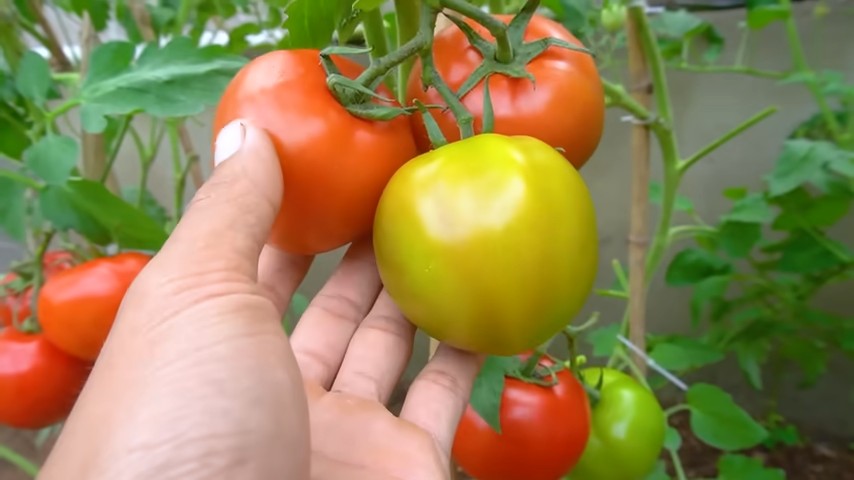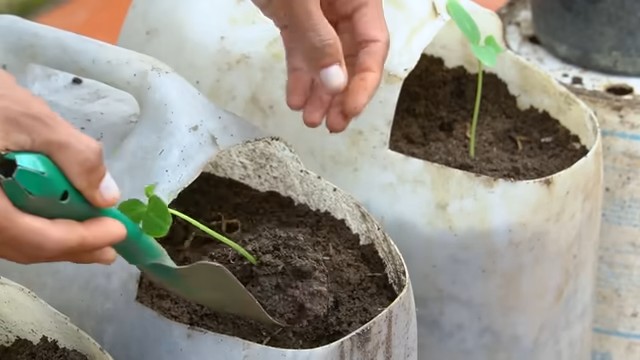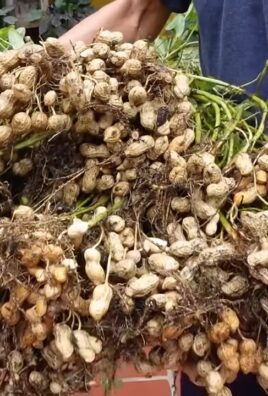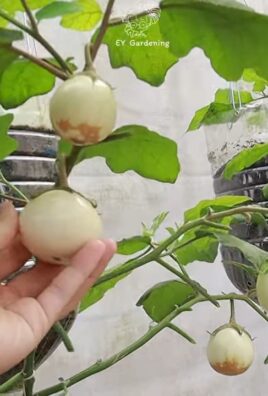Growing tomatoes indoors for beginners can seem like a daunting task, but trust me, with a few simple tricks and a little bit of patience, you can enjoy the taste of homegrown tomatoes all year round! Imagine biting into a juicy, sun-ripened tomato in the middle of winter – that’s the magic we’re about to unlock together.
The desire to cultivate our own food is deeply rooted in human history. From ancient civilizations tending their kitchen gardens to the victory gardens of World War II, growing your own produce has always been a source of sustenance, pride, and connection to the earth. Now, with limited space and busy lives, the trend of indoor gardening is booming, bringing that connection right into our homes.
But why should you bother growing tomatoes indoors for beginners? Well, for starters, you get to control the environment, protecting your precious plants from pests, diseases, and unpredictable weather. Plus, store-bought tomatoes often lack the flavor and freshness of homegrown varieties. This DIY guide will provide you with easy-to-follow steps and clever hacks to ensure a bountiful harvest, even if you’ve never grown anything before. I’m excited to share these tips with you, so let’s get started and transform your indoor space into a thriving tomato garden!

Growing Tomatoes Indoors: A Beginner’s Guide to Bountiful Harvests
Hey there, fellow gardening enthusiasts! Ever dreamt of enjoying fresh, juicy tomatoes even when the weather outside is frightful? Well, dream no more! Growing tomatoes indoors is totally achievable, and I’m here to guide you through every step of the process. It might seem daunting at first, but trust me, with a little patience and the right know-how, you’ll be harvesting your own homegrown goodness in no time.
Choosing the Right Tomato Variety
Not all tomatoes are created equal, especially when it comes to indoor growing. You’ll want to select varieties that are compact, determinate (meaning they grow to a certain size and then stop), and known for their productivity in smaller spaces. Here are a few of my personal favorites:
* Tiny Tim: As the name suggests, these are super compact and perfect for small pots. They produce adorable, bite-sized tomatoes.
* Roma: A classic choice for sauces and canning, Roma tomatoes are relatively compact and prolific.
* Patio: Bred specifically for container gardening, Patio tomatoes are reliable and produce a good yield.
* Tumbling Tom: These are trailing varieties that are ideal for hanging baskets. They produce cascades of sweet cherry tomatoes.
* Micro Tom: The smallest tomato plant available, perfect for a windowsill.
Gathering Your Supplies
Before we dive into the planting process, let’s make sure you have everything you need. Here’s a checklist of essential supplies:
* Tomato Seeds: Choose your desired variety from the list above or explore other compact, determinate options.
* Seed Starting Tray or Small Pots: These will be used to germinate your seeds.
* Seed Starting Mix: A lightweight, sterile mix that provides the perfect environment for seedlings.
* Larger Pots (5-10 gallon): These will be the permanent homes for your tomato plants.
* Potting Mix: A well-draining potting mix formulated for vegetables. Avoid using garden soil, as it can compact and hinder drainage.
* Grow Lights: Essential for providing adequate light, especially during the shorter days of winter. LED grow lights are energy-efficient and effective.
* Liquid Fertilizer: A balanced liquid fertilizer formulated for tomatoes.
* Watering Can or Spray Bottle: For gentle watering.
* Small Fan: To improve air circulation and prevent fungal diseases.
* Stakes or Cages: To support the plants as they grow.
* Pruning Shears or Scissors: For trimming and pruning.
* Optional: Heat Mat: To speed up germination.
Starting Your Tomato Seeds
This is where the magic begins! Starting your seeds indoors gives you a head start on the growing season and allows you to control the environment.
1. Prepare Your Seed Starting Tray or Pots: Fill your seed starting tray or small pots with seed starting mix. Moisten the mix thoroughly, but don’t soak it.
2. Sow the Seeds: Make a small indentation (about 1/4 inch deep) in the center of each cell or pot. Place 2-3 tomato seeds in each indentation.
3. Cover the Seeds: Gently cover the seeds with seed starting mix.
4. Water Gently: Water the seeds gently using a spray bottle or watering can with a fine rose. Avoid overwatering.
5. Provide Warmth: Place the seed starting tray or pots in a warm location. A heat mat can help speed up germination. The ideal temperature is between 70-80°F (21-27°C).
6. Maintain Moisture: Keep the seed starting mix consistently moist, but not soggy. You can cover the tray or pots with a clear plastic dome or plastic wrap to help retain moisture.
7. Provide Light After Germination: Once the seedlings emerge (usually within 5-10 days), remove the plastic dome or wrap and place them under grow lights. Position the lights a few inches above the seedlings.
8. Thin the Seedlings: Once the seedlings have developed their first true leaves (the second set of leaves), thin them to one seedling per cell or pot. Choose the strongest, healthiest seedling and snip off the others at the soil line.
Transplanting Your Seedlings
Once your seedlings have grown a few inches tall and have developed a strong root system, it’s time to transplant them into their permanent pots.
1. Prepare Your Larger Pots: Fill your 5-10 gallon pots with well-draining potting mix.
2. Carefully Remove the Seedlings: Gently remove the seedlings from their seed starting tray or pots. Be careful not to damage the roots.
3. Plant the Seedlings: Make a hole in the center of each pot that is large enough to accommodate the root ball of the seedling. Place the seedling in the hole and gently backfill with potting mix.
4. Water Thoroughly: Water the newly transplanted seedlings thoroughly.
5. Provide Support: Insert a stake or cage into the pot to provide support for the plant as it grows.
Caring for Your Indoor Tomato Plants
Now that your tomato plants are settled in their new homes, it’s time to provide them with the care they need to thrive.
1. Light: Tomato plants need at least 6-8 hours of direct light per day. If you don’t have a sunny window, use grow lights to supplement the natural light. Position the lights a few inches above the plants and adjust them as the plants grow.
2. Watering: Water your tomato plants regularly, but avoid overwatering. Allow the top inch of soil to dry out between waterings. Water deeply, until the water drains out of the bottom of the pot.
3. Fertilizing: Feed your tomato plants with a balanced liquid fertilizer every 2-3 weeks. Follow the instructions on the fertilizer label.
4. Temperature: Tomato plants thrive in temperatures between 65-85°F (18-29°C). Avoid exposing them to extreme temperatures.
5. Air Circulation: Good air circulation is essential for preventing fungal diseases. Use a small fan to circulate the air around your plants.
6. Pollination: Indoor tomato plants may need help with pollination. You can hand-pollinate the flowers by gently shaking the plants or using a small paintbrush to transfer pollen from one flower to another.
7. Pruning: Prune your tomato plants regularly to remove suckers (the small shoots that grow between the main stem and the branches). Pruning helps to improve air circulation and encourages fruit production.
8. Pest and Disease Control: Inspect your tomato plants regularly for pests and diseases. If you find any pests, such as aphids or whiteflies, you can treat them with insecticidal soap or neem oil. If you notice any signs of disease, such as leaf spots or wilting, remove the affected leaves and treat the plant with a fungicide.
Harvesting Your Tomatoes
The moment you’ve been waiting for! Your tomatoes are ready to harvest when they are fully colored and slightly soft to the touch. Gently twist the tomatoes off the vine. Enjoy your homegrown tomatoes in salads, sauces, or simply eat them fresh off the vine!
Troubleshooting Common Problems
Even with the best care, you may encounter some challenges when growing tomatoes indoors. Here are a few common problems and how to address them:
* Leggy Seedlings: This is usually caused by insufficient light. Make sure your seedlings are getting enough light, either from a sunny window or grow lights.
* Blossom End Rot: This is caused by a calcium deficiency. Make sure your soil is rich in calcium and water your plants consistently.
* Yellowing Leaves: This can be caused by a variety of factors, including overwatering, underwatering, nutrient deficiencies, or pests. Check the soil moisture, fertilize your plants, and inspect them for pests.
* Lack of Fruit: This can be caused by insufficient light, poor pollination, or extreme temperatures. Make sure your plants are getting enough light, hand-pollinate the flowers, and maintain a consistent temperature.
Growing tomatoes indoors can be a rewarding experience. With a little planning and care, you can enjoy fresh, homegrown tomatoes all year round. Happy gardening!

Conclusion
So, there you have it! Mastering the art of growing tomatoes indoors as a beginner is not only achievable but also incredibly rewarding. We’ve walked you through the essential steps, from selecting the right varieties and providing optimal lighting to ensuring proper pollination and consistent watering. This DIY approach to cultivating your own fresh, juicy tomatoes offers a multitude of benefits, far beyond simply having access to delicious produce.
Think about it: you’re bypassing the potential pesticides and long transportation routes associated with store-bought tomatoes. You’re gaining a deeper connection to your food source, understanding the life cycle of a plant, and experiencing the satisfaction of nurturing something from seed to harvest. Plus, let’s be honest, nothing beats the taste of a sun-ripened (or in this case, grow-light-ripened!) tomato picked fresh from your own indoor garden.
This method of growing tomatoes indoors is a must-try for several reasons. First, it extends the growing season, allowing you to enjoy fresh tomatoes even during the colder months. Second, it provides a controlled environment, minimizing the risk of pests and diseases that can plague outdoor gardens. Third, it’s a fantastic way to add a touch of green to your living space and create a calming, therapeutic atmosphere.
But don’t stop there! Experiment with different tomato varieties to discover your favorites. Try adding companion plants like basil or marigolds to your indoor garden to deter pests and enhance the flavor of your tomatoes. Consider using different types of growing mediums, such as coco coir or perlite, to see which works best for your setup. You can even explore hydroponic systems for a more advanced and efficient way to grow tomatoes indoors.
Growing tomatoes indoors is a journey of discovery, and we encourage you to embrace the process. Don’t be afraid to make mistakes – they’re all part of the learning curve. The most important thing is to start, observe, and adapt.
We’re confident that with a little patience and dedication, you’ll be enjoying homegrown tomatoes in no time. So, gather your supplies, choose your seeds, and get ready to embark on this exciting adventure.
We’d love to hear about your experiences! Share your tips, tricks, and photos of your indoor tomato gardens in the comments below. Let’s create a community of indoor tomato growers and learn from each other. Happy gardening!
Frequently Asked Questions (FAQ)
What are the best tomato varieties for growing indoors as a beginner?
Choosing the right tomato variety is crucial for indoor success. Determinate or bush varieties are generally recommended for beginners because they are more compact and require less support than indeterminate or vining varieties. Some excellent choices include:
* Patio Tomato: As the name suggests, this variety is specifically bred for container gardening and produces small, flavorful tomatoes.
* Tiny Tim: This is a dwarf variety that grows to only about a foot tall, making it perfect for small spaces. It produces cherry-sized tomatoes.
* Roma: While technically a determinate variety, Roma tomatoes can still benefit from some support. They are known for their meaty texture and are great for sauces and canning.
* Bush Early Girl: A compact version of the popular Early Girl, this variety is known for its early and abundant yields.
* Balcony Tomato: Another excellent choice for small spaces, this variety produces sweet, bite-sized tomatoes.
Remember to check the seed packet or plant label for specific information about the variety’s growth habits and requirements.
How much light do indoor tomatoes need?
Tomatoes require a significant amount of light to thrive indoors. Ideally, they need at least 6-8 hours of direct sunlight per day. However, since natural sunlight can be limited, especially during the winter months, supplemental lighting is often necessary.
Full-spectrum LED grow lights are the most efficient and effective option for indoor tomato growing. They provide the necessary wavelengths of light for photosynthesis and can be adjusted to meet the plants’ changing needs.
When choosing grow lights, consider the size of your growing area and the number of plants you’re growing. A general rule of thumb is to provide at least 32 watts of LED light per square foot of growing space.
Position the grow lights about 6-12 inches above the plants and adjust the height as the plants grow. Monitor the plants closely for signs of light stress, such as bleached leaves or stunted growth.
How do I pollinate my indoor tomato plants?
Tomatoes are self-pollinating, meaning they have both male and female parts within the same flower. However, indoor plants often require assistance with pollination because there is no wind or insect activity to help transfer pollen.
Here are a few methods you can use to pollinate your indoor tomato plants:
* Shaking the plants: Gently shake the plants a few times a week to release pollen.
* Using a small brush: Use a small, soft brush to transfer pollen from one flower to another.
* Using an electric toothbrush: Gently touch the back of each flower with an electric toothbrush for a few seconds to vibrate the pollen loose.
* Using a fan: Place a small fan near the plants to circulate air and help with pollination.
Pollinate your tomato plants in the morning when the pollen is dry and most viable. You’ll know pollination has been successful when the base of the flower starts to swell and form a small tomato.
What kind of soil should I use for growing tomatoes indoors?
The ideal soil for growing tomatoes indoors is a well-draining potting mix that is rich in organic matter. Avoid using garden soil, as it can be too heavy and compact for container gardening.
A good potting mix should contain a blend of peat moss, perlite, and vermiculite. Peat moss helps retain moisture, while perlite and vermiculite improve drainage and aeration.
You can also amend your potting mix with compost or other organic matter to provide additional nutrients.
Make sure the container you’re using has drainage holes to prevent waterlogging, which can lead to root rot.
How often should I water my indoor tomato plants?
Watering frequency will depend on several factors, including the size of the container, the type of potting mix, the temperature, and the humidity.
In general, you should water your tomato plants when the top inch of soil feels dry to the touch. Water deeply, until water drains out of the drainage holes.
Avoid overwatering, as this can lead to root rot. Also, avoid letting the soil dry out completely, as this can stress the plants.
Monitor your plants closely and adjust your watering schedule as needed. During hot, dry weather, you may need to water more frequently.
What are some common pests and diseases that affect indoor tomato plants, and how can I prevent them?
While indoor tomato plants are less susceptible to pests and diseases than outdoor plants, they can still be affected. Some common problems include:
* Aphids: Small, sap-sucking insects that can cause stunted growth and distorted leaves.
* Whiteflies: Small, white, flying insects that also suck sap from plants.
* Spider mites: Tiny mites that create webs on plants and cause yellowing and stippling of leaves.
* Fungal diseases: Such as powdery mildew and early blight, which can cause spots and lesions on leaves and stems.
To prevent pests and diseases, follow these tips:
* Start with healthy plants: Choose disease-resistant varieties and inspect plants carefully before bringing them indoors.
* Maintain good air circulation: Provide adequate ventilation to prevent fungal diseases.
* Water properly: Avoid overwatering and water at the base of the plants to prevent fungal diseases.
* Inspect plants regularly: Check plants frequently for signs of pests or diseases and take action promptly.
* Use organic pest control methods: If you do find pests, try using organic pest control methods, such as insecticidal soap or neem oil.
Can I grow tomatoes indoors year-round?
Yes, with proper lighting and care, you can grow tomatoes indoors year-round. The key is to provide consistent light, temperature, and humidity levels. You may need to adjust your growing conditions depending on the season. For example, you may need to increase the amount of supplemental lighting during the winter months.
How long does it take to grow tomatoes indoors?
The time it takes to grow tomatoes indoors will depend on the variety you’re growing and the growing conditions. In general, it takes about 60-85 days from transplanting seedlings to harvesting ripe tomatoes.
What kind of fertilizer should I use for indoor tomato plants?
Use a balanced fertilizer that is specifically formulated for tomatoes. Look for a fertilizer with an NPK ratio (nitrogen, phosphorus, potassium) of around 5-10-5 or 10-10-10.
Fertilize your tomato plants every 2-3 weeks, following the instructions on the fertilizer label. Avoid over-fertilizing, as this can damage the plants.
How do I know when my tomatoes are ripe?
Tomatoes are ripe when they have reached their mature color and are slightly soft to the touch. The color will vary depending on the variety. Gently twist the tomato off the vine when it is ripe.




Leave a Comment